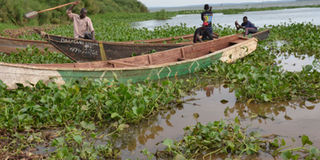Water weed blocks Jinja landing sites

Fishermen row through the water hyacinth at Wanyange Landing Site in Jinja District last week. PHOTO BY TAUSI NAKATO
Jinja- Fishermen at Wanyange and Masese landing sites in Jinja District are counting losses following re-invasion by the water hyacinth.
Mr Abed Wambuzi, the general secretary of Wanyange Landing Site, on Tuesday said they were earning Shs2,000 on every business boat that docks at the site but the activity has now been halted by the water weed.
“We tried to uproot the weed in vain. Earlier, both small and big boats could dock at the site but currently, someone may mistake it for a bush,” Mr Wambuzi said.
He said every Wednesday, the community does general cleaning of the lake shore. Fishermen use sticks to extract the aquatic weed.
Mr John Ochieng, a charcoal dealer at Masese Landing Site, said the weed has hindered boat movements because it forms a thick carpet of heavy floating plant.
“Several sections of the lake were cut off by the weed, affecting transport as boats and canoes can no longer access the shores. Sometimes it is ingested in boat engines that may cause serious accidents,’’ Mr Ochieng said.
Mr Abdul Nkona, a fisherman at Masese, said the area has become a breeding ground for mosquitoes and snakes.
“Many fishermen have already suffered severe malaria attacks,’’ he said.
The chairperson of Mafubira Sub-county, Mr Hamisi Kiganira, said the weed has also affected their revenue collections since his council no longer solicits money from traders who were offloading goods at the site.
“The Shs240m budget is not enough to run the activities of the council, including elimination of the weed,” he said.
Origin of weed
The head of National Agriculture and Forestry Research Institute, Dr Anthony Tabu, said water hyacinth is mostly associated with lakes that spew plenty of nutrients into the water.
“It can be removed manually but is costly because it involves paying people who have fuel and boats to remove them,” Dr Tabu said, adding that once the weed entangles with the nets, fishermen cannot get fish.
The water hyacinth became prominent in late 1980s and mid-1990s, with its impact mostly felt in 1995 when the weed covered 90 per cent of the Lake Victoria shoreline. It cuts off oxygen supply to aquatic life.
Environment experts say a combined approach to stop the further spread of the weed is necessary because it can be used as raw material for feeds and act as breeding spots for some aquatic lives.
The district environmental officer, Mr Moses Maganda, promised to forward the issue to the technical planning committee for assistance.
“We thought this weed was manageable only to discover that it has been resurging, but we shall sort it out,’’ Mr Maganda said.
[email protected]




